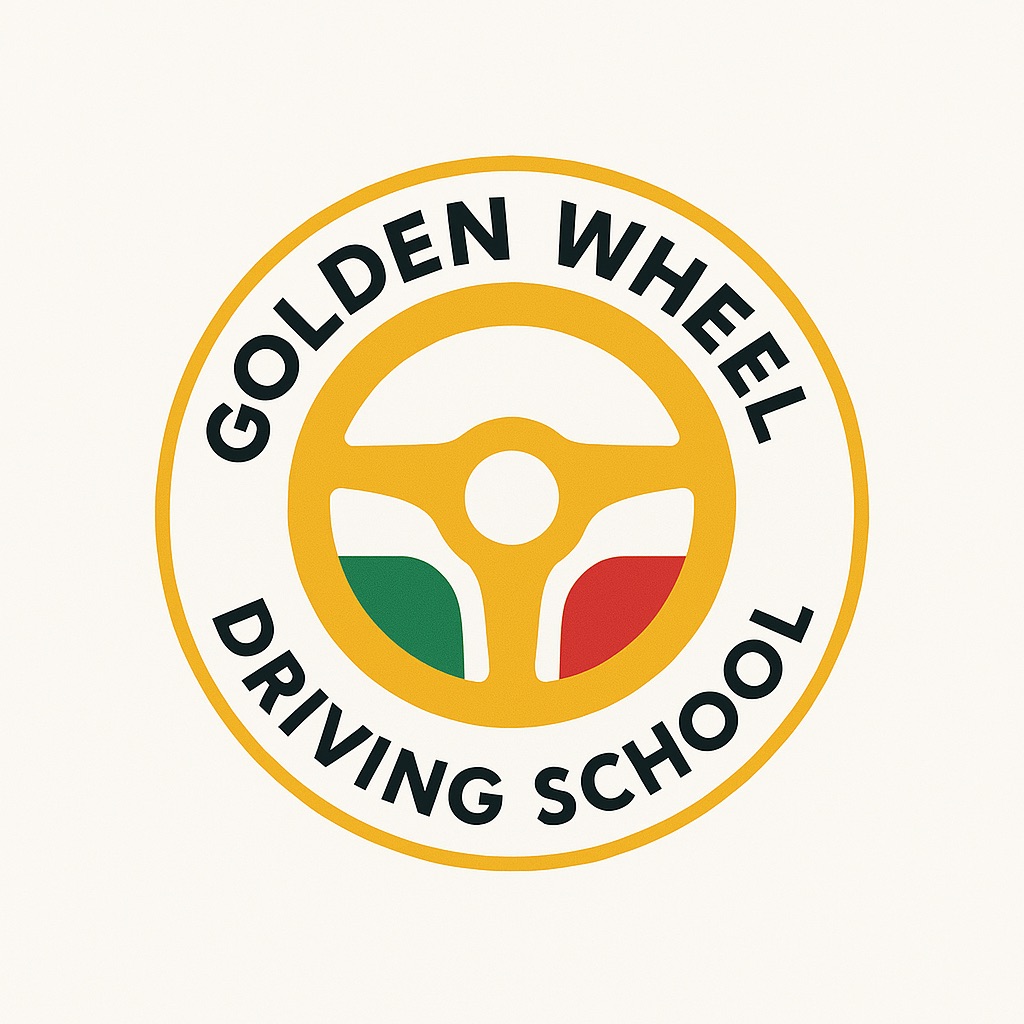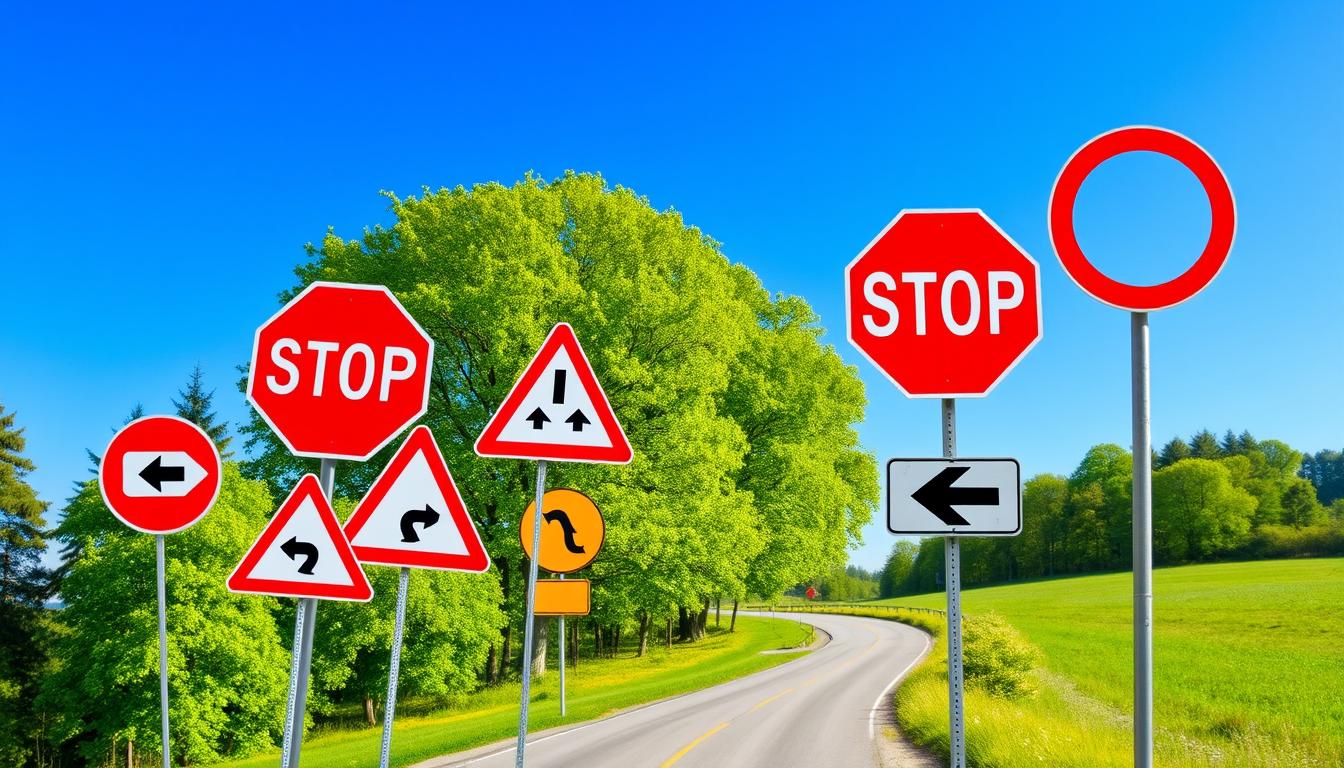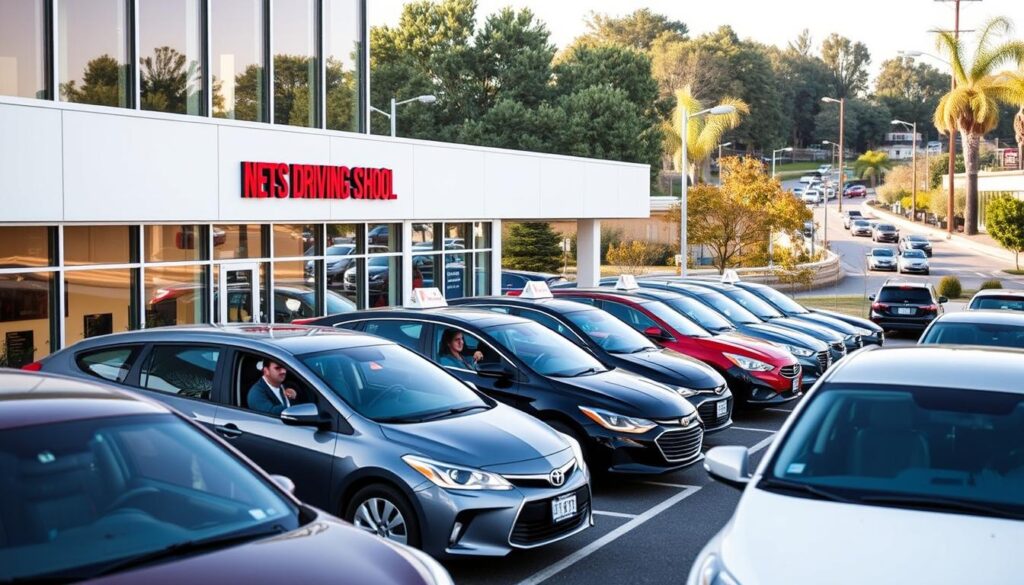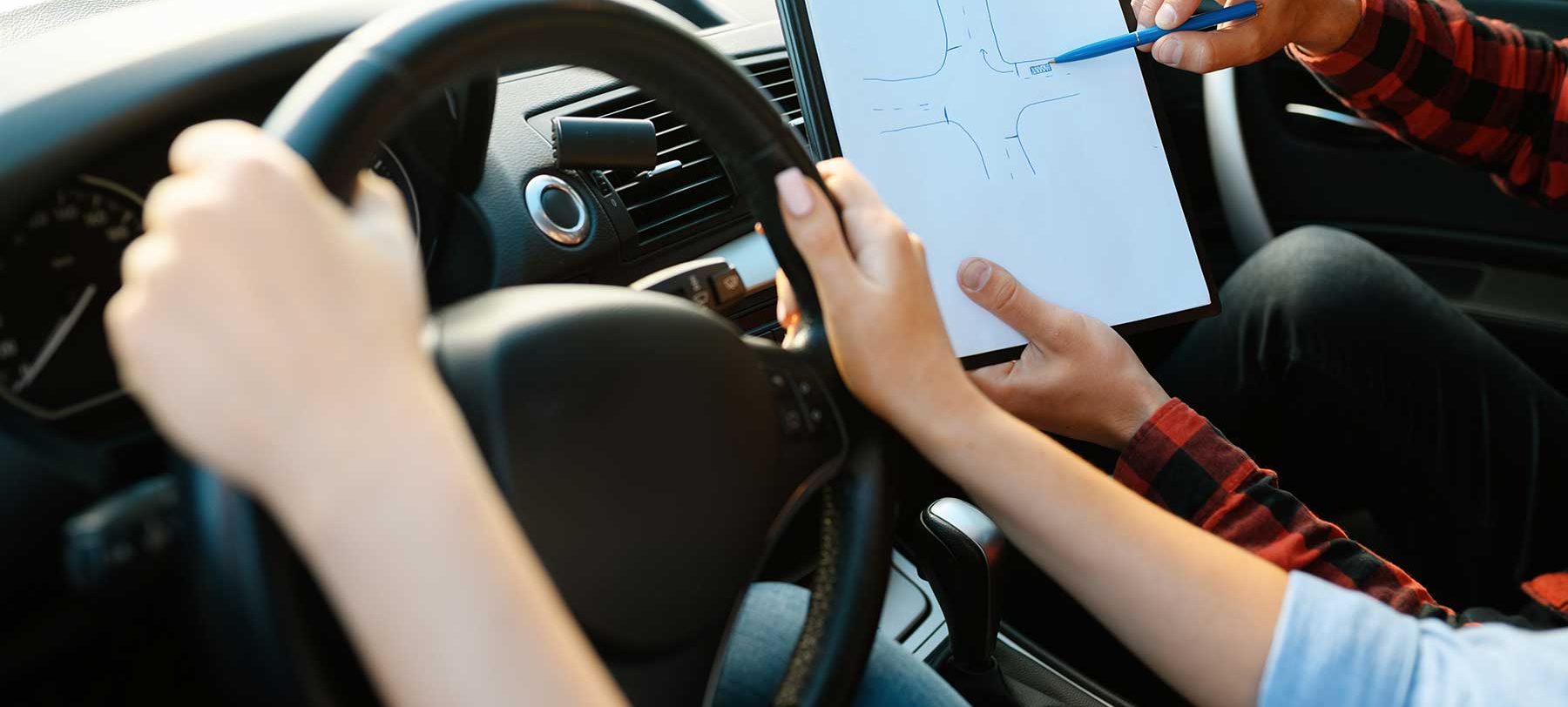Understanding road signs is key for your safety and others’ when you’re new to driving. Road signs tell you about traffic rules, dangers, and how to get around. This guide will help you learn about the different signs and why they’re important for safe driving.
Key Takeaways
- Road signs are essential for safe and efficient navigation on the roads.
- Understanding the different types of road signs, including regulatory, warning, guide, and construction signs, is crucial for new drivers.
- Recognizing and obeying road signs can help you avoid potential hazards and ensure the safety of yourself and others.
- Familiarizing yourself with road signs can improve your overall driving experience and confidence.
- Paying attention to school zone and pedestrian crossing signs is crucial for protecting vulnerable road users.
Introduction to Road Signs
Road signs are key tools for communication on the roads. They guide drivers, pedestrians, and others through the transportation network. These signs share important info about traffic laws, directions, and hazards. Knowing about road signs is vital for safe travel.
Why Road Signs Matter
Road signs are crucial for safety. They tell drivers about speed limits, traffic rules, and upcoming turns. By following these signs, everyone can avoid accidents and keep traffic moving smoothly.
Types of Road Signs
- Regulatory signs: These signs, such as stop signs and speed limit markers, outline the laws and rules that drivers must follow.
- Warning signs: These signs alert drivers to potential hazards, such as sharp turns, construction zones, or pedestrian crossings.
- Guide signs: These signs provide direction and information, guiding drivers to their destinations and highlighting important landmarks or services.
- Construction and temporary traffic control signs: These signs inform drivers of work zones, detours, and changes to the normal traffic flow.
- School zone and pedestrian crossing signs: These signs help protect vulnerable road users, such as children and pedestrians, by alerting drivers to areas where extra caution is required.
- Railroad crossing signs: These signs notify drivers of upcoming rail crossings, ensuring they remain vigilant and prepared to stop if necessary.
Knowing about different road signs helps everyone stay safe and confident on the roads. By paying attention to these signs, we can avoid accidents, reduce traffic jams, and keep our transportation system running smoothly.
Regulatory Road Signs
Knowing about regulatory road signs is key for safe driving. These signs tell us the rules of the road, like speed limits and stop signs. Following these signs helps keep everyone safe and avoids accidents.
Speed limit signs are very common. They tell us the max speed allowed on a road. Going over this speed can lead to fines or even losing your license.
Stop signs are also very important. Drivers must stop completely and let others go first. Not stopping at a stop sign can cause serious accidents and legal trouble.
| Regulatory Sign | Purpose | Consequences of Ignoring |
|---|---|---|
| Speed Limit Sign | Indicates the maximum legal speed for the road | Fines, license suspension |
| Stop Sign | Requires drivers to come to a complete stop and yield the right-of-way | Accidents, legal penalties |
| Yield Sign | Instructs drivers to slow down and yield the right-of-way to other vehicles or pedestrians | Accidents, legal penalties |
| Traffic Signals | Regulates the flow of traffic through intersections | Accidents, citations |
Traffic signals, like red and green lights, are also regulatory signs. They control who goes first at intersections. Drivers must follow these signals to avoid accidents and fines.
By following regulatory road signs, drivers help make the roads safer. It’s important to know what each sign means. This way, we can all drive more responsibly and safely.
Warning Signs
When we drive, it’s key to watch out for warning signs. These signs have special shapes and colors. They help us know when to slow down or change how we drive.
Recognizing Potential Hazards
Warning signs have different shapes and colors. Triangular signs tell us to slow down or watch out for a dangerous spot. Circular signs warn us about speed limits. Octagonal signs mean we must stop completely.
Knowing what these signs mean helps us get ready for what’s ahead. We can avoid dangers like sharp turns or slippery roads. Spotting these warning signs lets us act fast and stay safe.
Interpreting Warning Signs
It’s not just about seeing the shapes and colors of warning signs. We need to understand what they say and how to react.
- Curve signs: These alert drivers to an upcoming bend in the road, prompting them to slow down and adjust their speed accordingly.
- Pedestrian crossing signs: These warn drivers to be vigilant for pedestrians, especially in high-traffic areas or near schools.
- Slippery when wet signs: These indicate that the road surface may be hazardous due to wet conditions, requiring drivers to exercise extra caution and reduce speed.
By understanding each warning sign, we can make smart choices. This helps keep everyone safe on the road.
Road Signs
Street signs and highway markers are key for navigating roads. They give drivers and pedestrians important info. Each sign has its own shape, color, and size, all aimed at keeping us safe and moving smoothly.
These signs tell us street names, directions, and distances. Knowing them is vital for safe driving. It helps both new and experienced drivers avoid confusion.
We’ll look at road sign types, what they mean, and why we must follow them. By the end, you’ll know how to navigate roads confidently.
Regulatory Road Signs
Regulatory signs tell us about road laws. They include stop signs, yield signs, and speed limits. Following these signs is a safety rule and the law.
| Sign Type | Purpose |
|---|---|
| Stop Sign | Requires drivers to come to a complete stop before proceeding. |
| Yield Sign | Instructs drivers to slow down and give the right-of-way to other vehicles or pedestrians. |
| Speed Limit Sign | Indicates the maximum legal speed for that road or highway. |
It’s important to follow these signs for safety. Ignoring them can lead to fines or legal trouble.
“Obey the signs, and you’ll arrive at your destination safely. Ignoring them puts you and others at risk.” – Jane Doe, Traffic Safety Specialist
Guide Signs
As a driver, knowing how to navigate is key. Guide signs help you find your way to your destination. They guide you through places you don’t know well, making your trip smooth and quick.
Navigating with Guide Signs
Guide signs show you route numbers, exit ramps, distances, and destinations. By watching these signs, you can stay on course and avoid getting lost. They help you navigate, whether you’re in a new city or on a busy highway.
Learning about guide signs is the first step to better road navigation. Knowing their colors and symbols helps you understand them. Guide signs can be like your own GPS, guiding you through your journey.
When driving, always look out for these important signs. Guide signs make your drive easy and stress-free. So, next time you drive, let guide signs help you reach your destination.
Construction and Temporary Traffic Control Signs
As drivers, we’ve all seen those orange signs warning us of construction zones or traffic changes. These construction signs and temporary traffic control devices are key to our safety. They guide us through work areas and unexpected road conditions.
Construction zones can be tricky, with lane closures and detours. These signs help us navigate these areas safely. By following them, we can avoid dangers and keep traffic moving.
- Speed limit reductions in construction zones
- Merge warnings to alert drivers of lane closures
- Detour signs directing traffic to alternative routes
- Flaggers and pilot cars to control the flow of traffic
It’s vital to recognize and understand these construction signs and temporary traffic control devices. They give us crucial info to navigate work zones safely. This protects workers and all road users.
“Obeying construction signs and temporary traffic control devices is not only the law, but it’s also a matter of personal and public safety.”
By staying alert and following these signs, we help keep driving safe. Remember, these signs are there for a reason – let’s heed their instructions and keep everyone on the road safe.

School Zone and Pedestrian Crossing Signs
When we drive, we must think about the safety of our most vulnerable road users – children. School zone and pedestrian crossing signs are key to keeping them safe. These signs remind drivers to slow down and be careful, protecting our future.
Safeguarding Our School Zones
School zone signs are placed around schools to warn drivers to slow down. They often have flashing lights to catch the eye of drivers. By following these signs, drivers help make a safer place for students.
Navigating Pedestrian Crossings
Pedestrian crossing signs are similar, alerting drivers to watch out for people walking. They show where it’s safe for pedestrians to cross. By following these signs and yielding to walkers, we can avoid accidents.
Understanding the role of school zone and pedestrian crossing signs is important. We all have a part to play in keeping our children and communities safe. By being more aware and responsible, we can make our roads safer for everyone.
| Sign Type | Purpose | Key Characteristics |
|---|---|---|
| School Zone Sign | Alerts drivers to reduced speed limits and increased caution in areas near schools | Often features flashing lights or other visual cues to draw attention, indicates lower speed limits |
| Pedestrian Crossing Sign | Marks designated crossing areas for pedestrians, prompting drivers to yield and exercise extra vigilance | Typically accompanied by marked crosswalks, signals the need for drivers to be aware of people on foot |
“Protecting our children is of the utmost importance, and understanding the purpose of school zone signs and pedestrian crossing signs is a crucial step in creating a safer environment for all.”
Railroad Crossing Signs
Driving safely is very important. One key thing drivers need to know is about railroad crossing signs. These signs warn drivers about train tracks ahead. They remind us to slow down and stop if needed.
Knowing and following these signs can save lives. It makes sure our trips are safe and not tragic.
Recognizing Railroad Crossing Signs
Railroad crossing signs vary but all warn of upcoming tracks. The most common is the X-shaped “crossbuck” sign. It says “Railroad Crossing” and tells you to slow down and stop.
Other signs might have flashing lights or lowering gates. They all mean there’s a danger ahead.
It’s crucial to be careful and ready to stop at railroad crossings. Not doing so can lead to serious accidents.
Staying Cautious at Rail Crossings
- Slow down and be prepared to stop when approaching a railroad crossing.
- Carefully scan the tracks in both directions for any approaching trains.
- Never attempt to beat a train or cross the tracks if the warning signals are activated.
- If your vehicle stalls on the tracks, immediately exit the vehicle and move a safe distance away.
- Always obey the instructions and signals provided by railroad crossing signs.
By being alert and following signs, we keep ourselves and others safe. We also protect train operators and people walking or biking nearby.
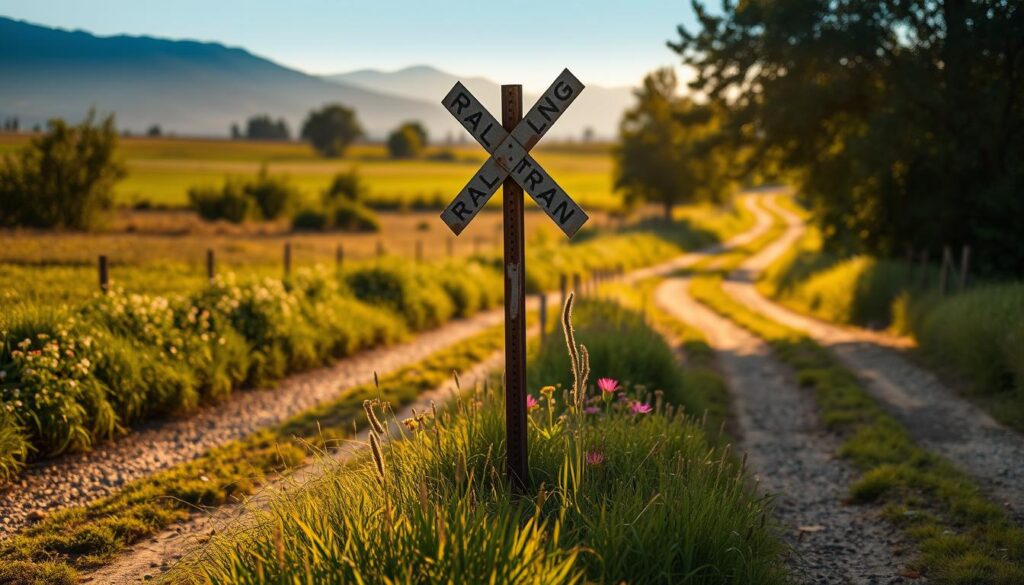
Railroad crossing signs are there to protect us. By listening to their warnings and being cautious, we help prevent accidents. This makes our roads and rail crossings safer for everyone.
Consequences of Ignoring Road Signs
As drivers, we must understand the importance of following traffic rules. Ignoring road signs can lead to serious problems for everyone on the road. It can result in fines, losing your license, or even criminal charges.
Ignoring road signs can also cause accidents. Traffic signs are there to keep us safe. Speeding or not stopping at signs can lead to crashes, damage, injuries, or even death.
- Fines: Disobeying traffic control devices can result in hefty fines, which can vary depending on the severity of the offense and the state or local jurisdiction.
- License suspension: Repeated violations or reckless driving may lead to the suspension or revocation of a driver’s license, making it illegal for them to operate a vehicle.
- Criminal charges: In some cases, ignoring traffic regulations can result in criminal charges, such as reckless driving or hit-and-run incidents, which can carry severe penalties, including jail time.
Ignoring road signs also affects our community. It makes our roads less safe and less efficient. We all need to drive responsibly to keep our roads safe and working well.
| Consequence | Description |
|---|---|
| Fines | Disobeying traffic control devices can result in hefty fines, which can vary depending on the severity of the offense and the state or local jurisdiction. |
| License Suspension | Repeated violations or reckless driving may lead to the suspension or revocation of a driver’s license, making it illegal for them to operate a vehicle. |
| Criminal Charges | In some cases, ignoring traffic regulations can result in criminal charges, such as reckless driving or hit-and-run incidents, which can carry severe penalties, including jail time. |
In conclusion, knowing the risks of ignoring road signs is key for all drivers. By focusing on road safety and following traffic rules, we help make our roads safer for everyone. Let’s all be careful and responsible drivers to avoid accidents and keep our roads safe.
“Ignoring traffic signals and signs is not only dangerous, but it’s also irresponsible and disrespectful to other road users. As drivers, we have a duty to follow the rules of the road and prioritize the safety of ourselves and others.”
Conclusion
Understanding road signs is key to safe driving. Knowing the different signs helps me drive better and avoid dangers. It’s not just about following the law; it makes driving safer and more fun.
I will always pay attention to road signs. They tell me about rules, warnings, and directions. This helps keep our roads safe and efficient.
Road signs are very important. They help guide us through the roads. By following them, I help make driving safer for everyone.
